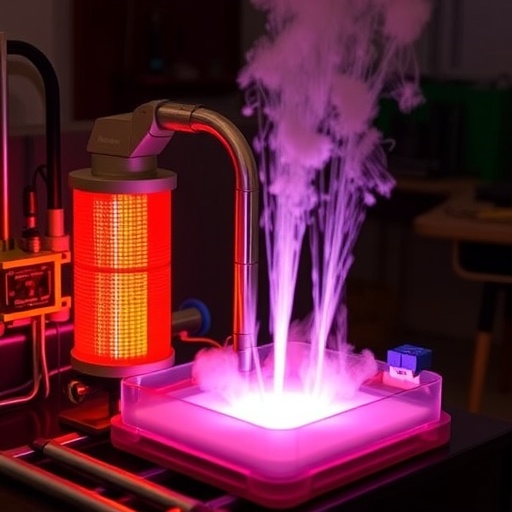In a groundbreaking study that holds promise for reducing industrial air pollution, researchers, led by scientists Geng, Gao, and Cao, have unveiled a novel approach to the simultaneous removal of sulfur dioxide (SO₂) and nitrogen oxides (NOₓ) from sintering flue gas using hydrated lime at low temperatures. The challenge of managing gas emissions in industrial processes has long plagued environmental science, prompting the need for innovative solutions that can operate efficiently under various temperature conditions. This research is particularly relevant as global industries are under increasing pressure to comply with stricter air quality regulations and to adopt more sustainable practices.
Sintering processes, commonly used in metal and mineral production, result in the generation of flue gases that contribute significantly to air pollution. The sulfur dioxide emissions stemming from these processes are known to cause acid rain, leading to severe environmental damage and health risks for surrounding populations. Similarly, nitrogen oxides are implicated in the formation of smog and respiratory problems. Their concurrent removal from industrial emissions is critical for both regulatory compliance and the protection of public health.
The utilization of hydrated lime for gas scrubbing represents a cost-effective and environmentally friendly option. This alkaline material has a high affinity for acidic gases, effectively neutralizing sulfur dioxide and nitrogen oxides when introduced into flue gas streams. The research team’s experimental setup focused on optimizing the conditions for hydrated lime application to maximize the removal efficiency of both pollutants at low temperatures—an achievement that could reshape industrial emissions management.
In the study, the researchers systematically varied several parameters, including the concentration of hydrated lime, gas flow rates, and reaction temperatures. This methodological approach allowed them to identify the ideal conditions for the highest removal rates of SO₂ and NOₓ. Remarkably, the results indicated that, under specific low-temperature conditions, hydrated lime could achieve removal efficiencies exceeding standard industry practices, highlighting the potential for broad adoption in various industrial settings.
Additionally, the study emphasizes the importance of understanding the chemical interactions occurring during the scrubbing process. By examining the reaction mechanisms between hydrated lime and the acid gases, the researchers are paving the way for improvements in the design and effectiveness of scrubbers used in industrial applications. Their findings reveal that the formation of intermediate compounds plays a crucial role in the efficiency of pollutant capture, suggesting avenues for further refinement of the approach.
The implications of this research extend far beyond immediate emission reductions. By demonstrating the feasibility of low-temperature operations, Geng and colleagues provide industries with a viable solution to address air pollution without incurring significant energy costs, which are often associated with traditional high-temperature scrubbing methods. This could lead to substantial economic and environmental benefits, making it an attractive proposition for industries seeking to upgrade their emissions control systems.
Furthermore, the study draws attention to the role of hydrated lime in closing the loop on industrial waste. The use of a byproduct like lime not only aids in pollution control but also promotes circular economy principles, where waste materials are repurposed for beneficial applications. This dual benefit underscores the potential for industries to align their operations with sustainability goals while enhancing their compliance with environmental regulations.
As global discussions on climate change and environmental protection intensify, the necessity for innovative solutions becomes more pressing. The findings from this study contribute to the broader body of knowledge on air quality management and underscore the urgent need for industries to adopt cleaner technologies. By showcasing the efficacy of hydrated lime at low temperatures, the research team opens up new avenues for further exploration and application in various sectors, from manufacturing to energy production.
In conclusion, Geng, Gao, and Cao’s research represents a significant step forward in the domain of emissions control. By effectively targeting the simultaneous removal of harmful pollutants from sintering flue gas, this study not only addresses an urgent environmental challenge but also paves the way for more sustainable industrial practices. The implications of this work are profound, demonstrating that innovative approaches can yield significant dividends in protecting both public health and the environment.
As industries grapple with the complexities of air pollution management, this research lays a robust foundation for the implementation of low-cost and effective scrubber systems. The authors envision a future where such technologies become commonplace, leading to cleaner air and a healthier planet. The next steps will likely entail pilot projects and real-world applications to validate these findings further.
This research constitutes a compelling antidote to ongoing environmental concerns, offering a beacon of hope in the fight against industrial air pollution and its detrimental consequences. By integrating science and industry, researchers continue to drive the push for innovation, sustainability, and public health in the face of emerging challenges.
Subject of Research: Simultaneous removal of SO₂ and NOₓ from sintering flue gas using hydrated lime at low-temperature.
Article Title: The simultaneous removal of SO2 and NOx from sintering flue gas with hydrated lime under low-temperature.
Article References:
Geng, S., Gao, G., Cao, T. et al. The simultaneous removal of SO2 and NOx from sintering flue gas with hydrated lime under low-temperature.
Environ Sci Pollut Res (2025). https://doi.org/10.1007/s11356-025-37223-4
Image Credits: AI Generated
DOI: https://doi.org/10.1007/s11356-025-37223-4
Keywords: air pollution, emissions control, hydrated lime, low-temperature scrubbers, industrial processes




